Irish Music in the Hills
by Joshua Heston
The fiddle, the accordion, plectrum banjo, bodhran, penny whistle, piano. The heartbeat of the Irish people is in this small European nation’s music — a music that has given so much to pan-American culture and Ozarkian culture specifically.
While Irish harpists are not a dramatic part of our Ozark heritage, the heart for such music is a powerful reminder of our roots.
May 5, 2012
Heritage of the Irish Harp
from Dearbhail Finnegan
The harp is the national emblem of Ireland. It’s interesting, because Ireland is the only country in the entire world to have a musical instrument as its national emblem. I think that gives you an idea of how important this is to us, both historically and culturally.
In the old traditional style of harp playing, there are three different styles: Suantri, Gentrai and Goltrai.
Suantri means lullaby music — soft gentle music. Gentrai means happy, delightful music — the kind that you get up and you dance to (the reels, the jigs and that). Goltrai are laments, the sad songs — Gol is Irish Gaelic meaning to cry.
So they had the sad pieces of music — the laments of famine times or laments of somebody parting or those moments where the piece of music reflected sadness rather than a joyous occasion. Traditionally — in the harping world — you had to be proficient in all three styles of music to be a rounded musician.
Today, most musicians would like to be able to play all three styles proficiently because otherwise you are not really playing traditional Irish music completely. So those are the three different styles and dating back to the harp players, who were the first musicians of Ireland (along with the uillean pipers). The original harpers played a lot of the Goltrai and Gentrai as well as the Suantri (the lullaby music) because they were the only musicians who were playing for the high kings.
They were the court musicians. And just as they would hire a storyteller, they would also hire a harpist. In the old days, the news would be referred through the harp and the voice. And then the music changed quite a lot —for the harp players I'm referring to completely now — because the instruments started to change.
Years ago, the harp players played with their nails and they played on wire-strung harps which were small instruments that would either sit on your knee or you would sit down on the ground to them. They would be only three-and-a-half foot tall or something like that with lesser strings.
And then as time went on, the development of the harp, and also the movement of people in and out of Ireland — at this point, if you move up even into the 14th and 15th century, the harp started to change. And then definitely by the time it got to the 16th and 17th century — of the likes of Turlough O'Carolan and lots of the different harp players of Ireland — they introduced a new style of playing.
The harps got much bigger (bigger than my harp now) and they started the style of cutting down your nails and playing with the sides of your fingers which is now the concert (or European) harp style of playing. So the music changed so that the sound drastically changed.
How you played a march in those days was very simple in your accompaniement levels.
Nowadays it is just a very different style and there are some harp players in Ireland that are really developing the dance style side of it. There are some really, really excellent players playing the dance music just as good as a fiddle or an accordion or anyone else playing with complicated finger patterns. The harp has positively been a part of Irish culture since the seventh or eighth century. But there have been images of harps on the old high crosses, which were before that. However, we don’t have any evidence of the music they would have played or a physical harp to show.
Really, the earliest documentation on the Irish harp comes from European musicians who came over and commented on how wild the Irish people were. They actually called them an “ignorant race with incredible ability to play the harp.” So that was the only thing that came out of the travelers who came out of mainland Europe into Ireland! But that was after the seventh century.
From a personal experience, my grandfather was a fiddle player. So we grew up right beside my grandfather and he played all the old kind of music, like Shoe The Donkey and simple little tunes like that. He taught us all how to play fiddle. And actually, to tell you a funny story, my brother wanted a guitar and my grandfather said that if a guitar was brought into our neighborhood, then he would stop teaching us all. That’s how alien a guitar was and wouldn’t be seen played by any one of us. So that was how strict he was that we were going to learn traditional Irish music and nothing else.
But that's not how it has stayed. But I suppose I’d be grateful for him that he did that because at least we had some grounding in traditional music.
May 9, 2006
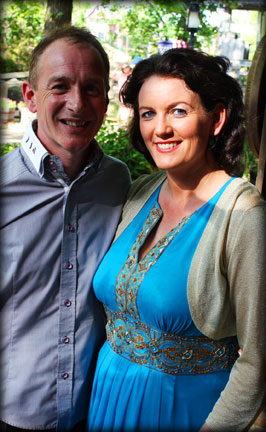
Plate 1. Dearbhail Finnegan with husband Robin Slater.
Dearbhail Finnegan is one of Ireland's most sought-after harpists.
Born and raised in Nobber (An Obair), Co. Meath, Ireland, (the birthplace of Ireland's most famous harper/composer Turlough O'Carolan) Finnegan has performed at the White House (50th anniversary of NATO) and appeared with her husband Robin Slater in Zurich, Switzerland by appointment of the Irish Embassy.
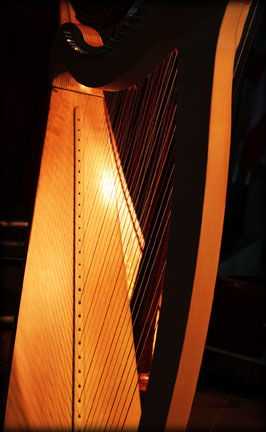
Plate 2.
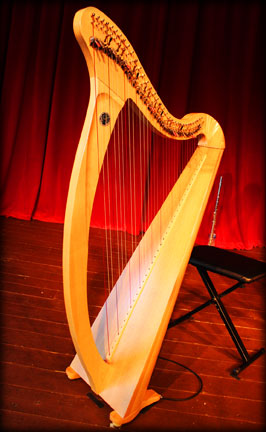
Plate 3.
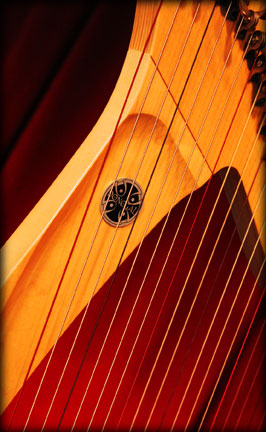
Plate 4.
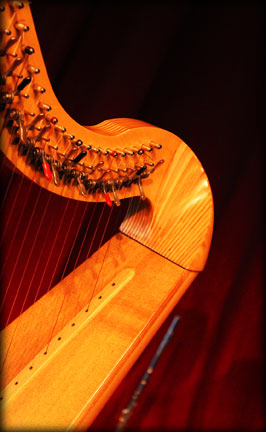
Plate 5.
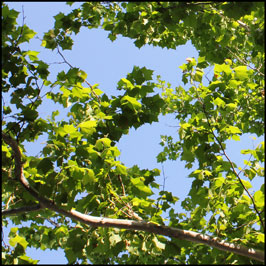
Plate 6.



